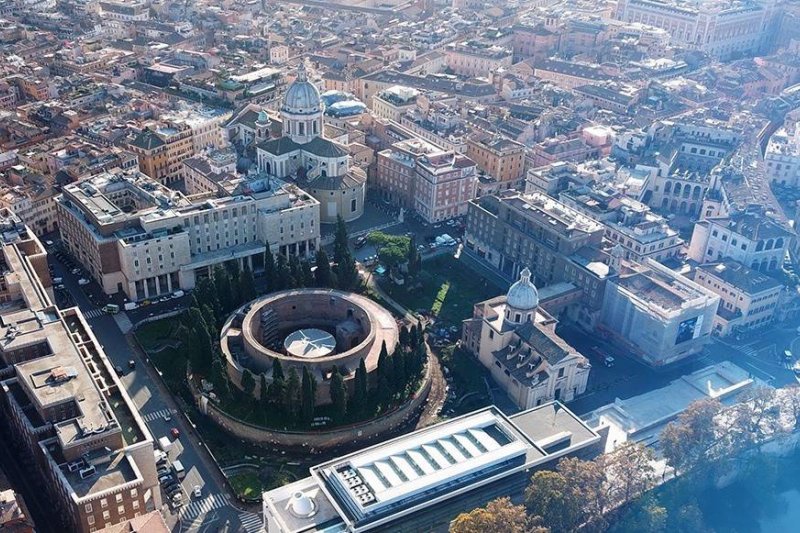The Mausoleum Of Augustus And Its Restoration Project
ome is a city with a glorious history that leaves everyone in awe by its landmarks, monuments, and attractions. The ancient Roman ruins and architecture cohabit with the modern and contemporary Italian architecture, making Rome, indeed, “an open-air museum.â€
The founder of the Roman Empire, emperor Augustus Caesar, filled Rome with monuments recalling his victories. Among the many architectural landmarks built, one of the most significant monuments still standing in Rome is the Mausoleum of Augustus. This architectural landmark used to be one of the most beloved and enduring icons of the city, not to mention the largest circular tomb monument in the world.
With the Roman Empire’s birth, the first dynastic sepulchre was raised in Rome–the Mausoleum of Augustus. Built in 28 BC, this tomb is one of the most well-known monuments in the Roman Empire and worldwide. So much so that after 80 years of being closed, the Italian telecommunications company TIM has donated €6 million to restore the Mausoleum.
The Mausoleum of Augustus
The Mausoleum of Augustus was the first of many significant building projects undertaken during the reign of Rome’s first emperor. Built in 28 BC, it was the most immense tomb in the Roman world. The Mausoleum was described then as a huge building, all white and surrounded by many trees, with a bronze statue of Augustus at the top of the roof. But what led to its abandonment over the eras?
For over a century, the Mausoleum of Augustus was used as a burial site for the relatives and descendants of Augustus, up until the later emperors abandoned it and started building mausoleums of their own. With the fall of the Roman Empire, the Colonna family had the Mausoleum fortified and turned into a castle during the Middle Ages. Unfortunately it was then sacked and its statutes, materials and marbles were reused to build other monuments and buildings.
The Mausoleum kept on changing ownership and purpose, from a hanging garden to an amphitheatre for bullfights, from theatre to the most famous music hall in Europe. Up until during the Fascist period, Mussolini decided to restore the monument. The restoration project was divided into various phases, the first of which included demolishing the buildings that had been erected on top of the Mausoleum over the centuries. With the break out of the Second World War, the restoration works were interrupted. The tomb was closed to the public until in 2007, new archeological excavations were made and in 2016 a new restoration project began, with the objective of giving this stunning monument its deserved place in Rome’s historic center.
The Restoration Project
The restoration project funded by Fondazione TIM is divided into two phases: the consolidation of existing structures to make them safe and accessible, and the enhancement that will allow a new use for the installation.
To consolidate the structure, reconstructions are needed to prevent any new damage or collapse. The first task was to transfer 153 ancient archaeological remains. Once the project is completed, they will return to the Mausoleum. The cleaning, filling, and shielding has made it possible to get rid of the vegetation that had taken root on the walls. And to stop future water penetration inside the masonry, the buildings’ surface has been coated with a thick protective barrier. A shield against rain has also been installed.
Surrounding the monument, there will be pedestrian area, filled with greenery, providing a direct connection between the level of today’s city and that of the imperial city. An additional corridor will be built to allow the public to experience the monument from the outside.
A 3D online experience during COVID-19
The Mausoleum of Augustus in Rome was scheduled to reopen in 2020. However, due to the COVID-19 regulations, it will probably be delayed. Nevertheless, until its official opening, you can learn about Augustus and the interesting story of the Mausoleum through the dedicated website in 3D mausoleodiaugusto.it.
Who was Augustus Caesar?
Augustus Caesar (Gaius Octavian – original name) was the first Roman Emperor, successor of Julius Caesar and one of the most significant administrative geniuses in history. The immense reorganization work he carried out transformed the collapsing republic into a modern, monarchic regime.
Augustus transformed the Roman people into builders of a glorious Empire. The Emperor gave the city important monuments and remarkable reconstructions. He wanted them to remain at the Roman people’s disposal, such as the Theatre of Marcellus, the Pantheon, the Ara Pacis solar clock on-campus Martius, the Temples of Jupiter, and the Temples of Apollo.
Rome gradually became an empire where there was an appreciation for art, theatre, poetry, architecture, and cultural activities. Not only was the Mausoleum converted into a concert hall, bull-fighting arena, and circus acts in the late 19th and early 20th-century, but it was most notably a burial site for Augustus’ family.
The original purpose of the Mausoleum was to retain relatives of this family. Those buried within it included the nephew of Augustus, Marcellus (died 23 BCE), his son-in-law, Marcus Agrippa (12 BCE), Drusus, the Elder (9 BCE), the two sons of Augustus, Lucius and Gaius Caesar (2 and 4 CE), and the Emperor himself in 14 CE. A long line of associations and spouses followed, including Drusus the Younger, Livia, Tiberius, Agrippina, Nero, Drusus (Caligula’s brother), Poppaea, and Nerva.
(Source: romeing.it)













